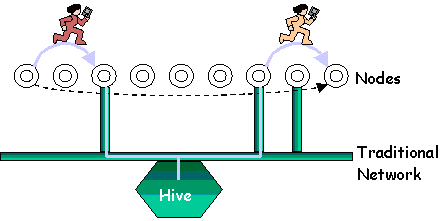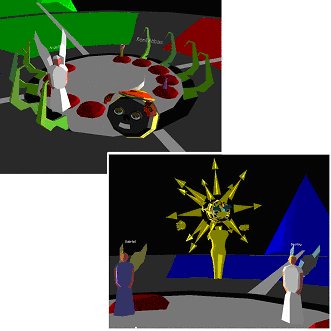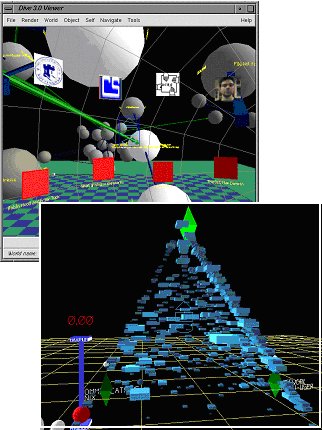Large screen user interfaces

As part of the European funded project Campiello, I worked for Xerox Research Centre Europe investigating the use of large screen displays as a means to support serendipitous information discovery and to support awareness between the members of a community or workgroup.The resulting display is designed to look visually appealing and avoid the standard rectangular grid-style layout found on most computer user interfaces.
Networking devices using people instead of wires

In the course of their workday, people move about visiting different locations, seeing different people and using several different artefacts. This movement in part of their everyday work. In a similar fashion bees move from flower to flower in a field, in search of nectar. However, a bee also inevitably collects pollen on its body when it visits a flower and, when it moves to a different flower, some of this pollen rubs off.
The Pollen network (at Xerox Research Centre Europe) exploited this movement of people to provide a means of transmitting information between people and devices without depending on a fixed (wired or wireless infrastructure). In a Pollen network, people carry an electronic form of pollen with them, not on their bodies, but inside their personal digital assistants (PDAs, such as the Palm or the Psion, etc.) or inside other mobile devices, such as cellular telephones. When two devices come in contact they exchange Pollen messages, thereby providing an indirect means of information transfer. The movement of people is thereby harnessed to create a new kind of computer network.
Collaborative Virtual Performances

Collaborative virtual environments provide many opportunities for new forms of artistic expression. In one event in Nottingham in November 1996 we (the Communications Research Group at Nottingham University, UK) created an event in which hip-hop poets were able to perform simultaneously to both live and virtual audiences.The virtual audience was able to see, hear and interact with the poets in an environment designed by a UK graphic designer. In addition the virtual world allowed the audience members to see, and communicate with each other, as well as providing other examples of the poets work for them to explore. Meanwhile the audience in the real world as well as being able to enjoy the real performance were able to see the activities taking place in the virtual environment by means of public projected displays.
In 1997 we staged worked with a local artist in which up to five people at once could explore a virtual art installation populated with autonomous agents. The users were able to see and hear each other
Visualising Information

Not only is the amount of information that we have access to increasing in volume, it is also increasing in complexity. Trying to understand complex structures, such as software, the relationships of documents in a collection to one another or hypermedia databases is not a trivial matter.To make matters worse, information of this kind has no natural physical representation. Unlike measurements of wind speed around a component in a wind tunnel there are no physical artefacts to relate such data to. A long standing interest of mine has been to “make the intangible tangible” by trying to find appropriate techniques for representing such data.In addition it is important to realise that people do not work in isolation and so these visualisation are not just single-user environments but actively support multiple users and allow them to be aware of the actions of others which might indirectly affect their own work.
The images above show the WWW3D 3D web browser (left) and the VR-VIBE system for interactive searching of document collections (right).